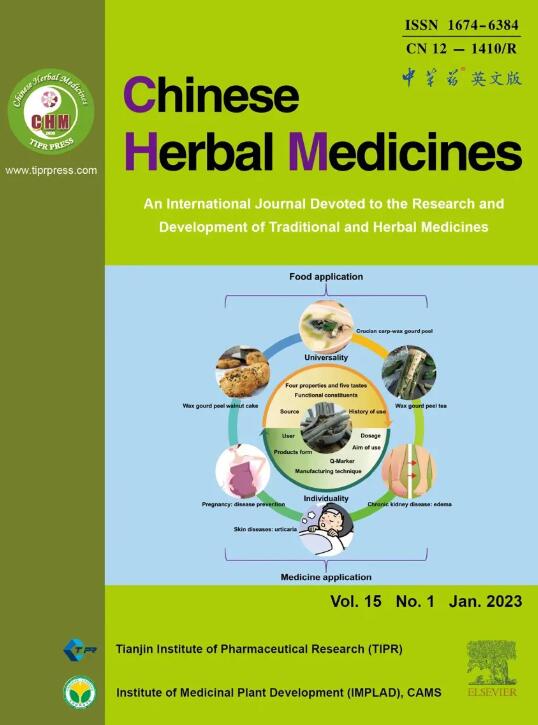柚子皮中的黄酮类化合物可抑制人胰岛淀粉样多肽纤维的形成
IF 8.9
4区 医学
Q1 CHEMISTRY, MEDICINAL
引用次数: 0
摘要
目的探讨人胰岛淀粉样多肽(hIAPP)(胰淀素)纤维的形成和聚集,对促进2型糖尿病(T2DM)的预防和治疗具有重要意义。柚皮中的黄酮在抗糖尿病方面具有明显的生物活性。本研究旨在研究柚皮中五种黄酮[柚皮苷(naringin, NRG)、柚皮素(narirutin, NRR)、柚皮素(NOB)、柚皮素(sinensetin, SIN)和新橙皮苷(nehesperidin, NHP)]对肽聚集的影响,并探讨其可能的机制。并对黄酮抗肽聚集的细胞活力进行了评价。方法采用硫黄素T (ThT)测定法和透射电镜(TEM)观察黄酮类化合物对多肽聚集的抑制和分解作用。通过内源荧光、分子动力学(MD)模拟、紫外光谱(UV)和等温滴定量热(ITC)实验分析了相互作用机理。采用3-[4,5-二甲基噻唑-2-基]-2,5-二苯基溴化四唑(MTT)和免疫实验表征黄酮抗肽聚集的细胞活力。结果在不同的hIAPP摩尔比下,5种黄酮类化合物的荧光强度、纤维数量和大小均有所降低。该化合物可与芳香酪氨酸(Tyr)残基ety37结合,导致多肽的固有荧光猝灭。五种黄酮类化合物可以与hIAPP形成氢键,这可能是基于它们的酚羟基结构。它们与多肽具有较强的结合亲和力。NRG和NRR的反应体系为放热反应,其余为吸热反应。掺入hIAPP的化合物的吸收峰发生了变化,并表现出异色效应,表明可能存在π-π堆积相互作用。在淀粉样肽存在的情况下,黄酮显著提高了细胞活力,降低了肽寡聚物诱导的吸收强度。结论柚皮中5种黄酮对淀粉样蛋白原纤维具有抑制和解聚作用,能显著保护细胞免受hIAPP的毒性作用,减少毒性低聚物的产生。本文章由计算机程序翻译,如有差异,请以英文原文为准。
Flavones in pomelo peel resist fibril formation of human islet amyloid polypeptide
Objective
Exploring the formation and aggregation of human islet amyloid polypeptide (hIAPP) (amylin) fibers is significant for promoting the prevention and treatment of type II diabetes mellitus (T2DM). Flavones in pomelo peel have visible biological activity in the anti-diabetes aspect. The present study aimed to investigate the effects of five flavones [naringin (NRG), narirutin (NRR), nobiletin (NOB), sinensetin (SIN), and neohesperidin (NHP)] in pomelo peel on peptide aggregation and explore its possible mechanisms. The cell viability of flavones against peptide aggregation was also evaluated.
Methods
The thioflavin T (ThT) assay and transmission electron microscopy (TEM) were used for evaluating the inhibition and disaggregation of flavones on peptide aggregation. The interaction mechanism was analyzed by endogenous fluorescence, molecular dynamics (MD) simulations, ultraviolet spectroscopy (UV) and isothermal titration calorimetry (ITC) experiments. The 3-[4,5-dimethylthiazol-2-yl]-2,5-diphenyl tetrazolium bromide (MTT) and immune assays were performed to characterize the cell viability of flavones against peptide aggregation.
Results
The five flavones showed a decrease in fluorescence intensity, fiber number and size under incubation with different molar ratios of hIAPP. The compounds can bind to the aromatic tyrosine (Tyr) residueTyr 37, resulting in the intrinsic fluorescence quenching of the peptides. Five flavones can form hydrogen bonds with hIAPP, which is likely to be based on their phenolic hydroxyl structure. They showed strong binding affinity with peptides. The reaction system of NRG and NRR observed an exothermic reaction, and the others were endothermic reactions. The absorption peaks of the compounds with hIAPP changed and showed hypochromic effects, indicating that there may be π-π stacking interaction. Flavones noticeably increased the cell viability in the presence of amyloid peptides and reduced the absorption intensity induced by peptide oligomers.
Conclusion
A total of five flavones in pomelo peel have inhibitory and depolymerization effects on amyloid fibrils, and can significantly protect cells from the toxic effect of hIAPP and reduce the production of toxic oligomers.
求助全文
通过发布文献求助,成功后即可免费获取论文全文。
去求助
来源期刊

Chinese Herbal Medicines
CHEMISTRY, MEDICINAL-
CiteScore
4.40
自引率
5.30%
发文量
629
审稿时长
10 weeks
期刊介绍:
Chinese Herbal Medicines is intended to disseminate the latest developments and research progress in traditional and herbal medical sciences to researchers, practitioners, academics and administrators worldwide in the field of traditional and herbal medicines. The journal's international coverage ensures that research and progress from all regions of the world are widely included.
CHM is a core journal of Chinese science and technology. The journal entered into the ESCI database in 2017, and then was included in PMC, Scopus and other important international search systems. In 2019, CHM was successfully selected for the “China Science and Technology Journal Excellence Action Plan” project, which has markedly improved its international influence and industry popularity. CHM obtained the first impact factor of 3.8 in Journal Citation Reports (JCR) in 2023.
 求助内容:
求助内容: 应助结果提醒方式:
应助结果提醒方式:


